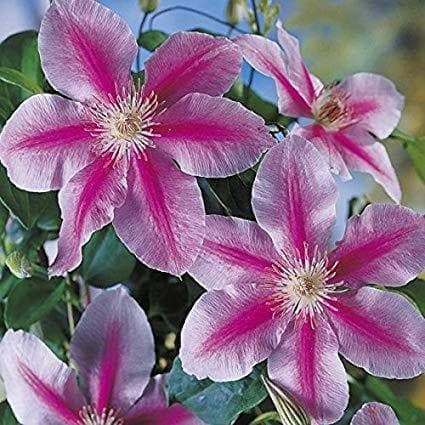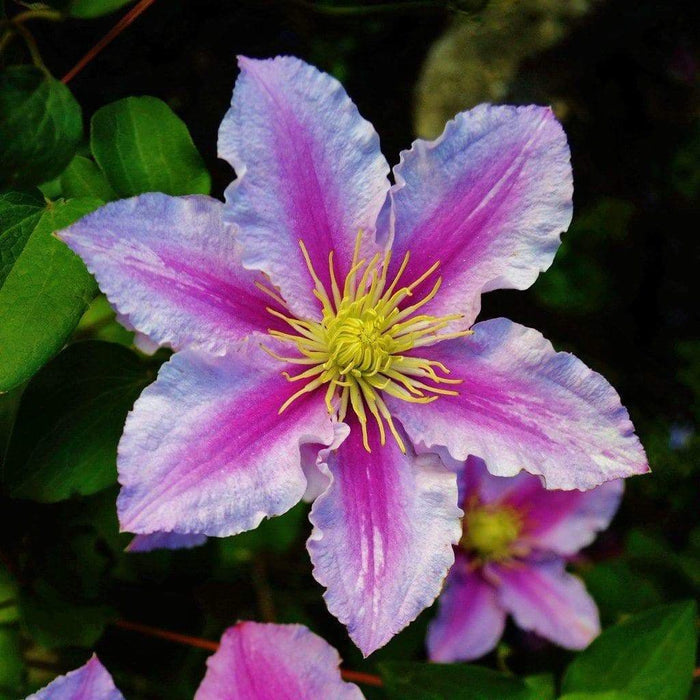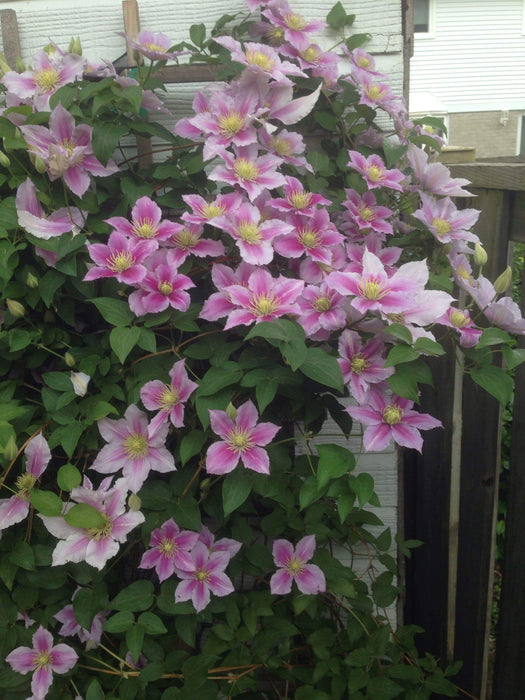![[Seeds] - Caribbeangardenseed](http://caribbeangardenseed.com/cdn/shop/products/clematis-piilu-8473-1-p_700x700.jpg?v=1679796417)
Clematis Piilu (STARTER) PERENNIAL flowering Vine
Most orders are processed by the next day
Select your desired size and/or color from the available options.
Clematis Piilu or Little Duckling
'Piilu’ means little ducking, and these sweet blooms will endear you each season. Frilly in earliest blooms, but always charming. The tone on tone shades of pink are one of a kind and a must for the collector.
Considered by many as one of, if not the heaviest-blooming Clematis around, with 4″ flowers continually from May right through October. The pale purple-pink petals are patterned with a broad dark-pink central streak. The early flowers are double while the later ones are single. Another outstanding characteristic, Piilu blooms from the top of the plant all the way down to the bottom, unlike others which leave the bottom bare. Grows 72″ tall, 15″ wide.
A member of pruning group 2. In early spring prune off dead or spindly wood, careful not to prune off old good wood or early flowers will be lost. Prune again right after first flush of blooms to encourage second bloom. Prune back some stems one-third to one-half by cutting to large buds or a strong side shoot immediately below the spent blooms.
Clematis are one of the most popular groups of garden perennials. These flowering vines can be worked over an arbor, threaded through other perennials or secured up a tree. Growing them is fairly easy. But pruning clematis tends to instill fear in the stoutest of gardeners. This fear is unwarranted, since pruning clematis simply breaks down to a question of when your clematis blooms. Plant bareroot clematis in early spring while the plants are still dormant
Group Two: These Clematis flower on both previous seasons growth and new growth. Prune lightly in winter to big buds making sure to cut out all weak, cluttered and dead growth. After the spring flowering, prune again to remove all the spent flowers to encourage a fresh set of flowers in summer. If the plant is sparse, prune harder to encourage branching. Feed after each pruning to encourage new growth. (This group includes most of the Large Flowered Hybrid Clematis. )
PLANTING CLEMATIS IS AS EASY AS 1-2-3
1. Loosen the soil to a depth of 12” and mix in several handfuls of compost and ¼ to ½ cup of all-purpose granular fertilizer (follow package directions).
2. Dig a hole deep enough for the roots, and position the clematis so the crown of the plant (where the roots meet the stem) is right at the soil line.
3. Cover the roots with soil, allowing the growing tips to be barely visible.
TIPS FOR PLANTING CLEMATIS
Though clematis like their “heads” in the sun, the bottom of the plant should be shaded so the roots stay relatively cool.
During the first growing season, your new clematis should be watered whenever the weather is dry. Mulching around the base of the plant will help retain moisture and keep the roots cool. Sometimes clematis need a little help holding onto a trellis or structure. You can use soft twine, waxed string or even zip-ties to attach the vines and provide extra support.
Prune clematis vines to encourage new growth, which results in more flowers.
No matter which pruning category your clematis plants fall into, flowering will diminish on all clematis vines without pruning.
Left unpruned the new growth is confined to the tops or ends of the vines and that is where your flowers will be
CARING FOR CLEMATIS AFTER THEY BLOOM
After the flowers fade, some clematis develop decorative seed heads. These can be left in place throughout the growing season. Though it's not necessary, you can also cut off the seed heads to keep the plant looking neat. Some clematis varieties bloom again in late summer or early fall. If you think your clematis could be a rebloomer, remove only the spent flower heads and avoid cutting back the foliage.
Early spring is the best time to prune a clematis. There are two approaches to pruning. Some varieties produce new growth on last year’s vines, so they should only be pruned to shape the overall plant. Others varieties die back to the ground. Since any new growth comes from the base of the plant, all of the prior year's vines can be removed. Until you get to know your clematis, it’s best to wait until the plant has sprouted new growth. That way you can see where it's coming from and prune accordingly.
Fertilize your clematis in the spring when the first leaves start to unfurl. Follow package instructions, sprinkling approximately ¼ to ½ cup of all-purpose granular fertilizer around the base of the plant.
If your clematis outgrows its space, you can control the growth by simply cutting back the entire plant to a height of 5". This can be done in fall or early spring. Stray vines may also be trimmed back any time during the growing season.
LET OUR CUSTOMER SPEAK FOR US

![[Seeds] - Caribbeangardenseed](http://caribbeangardenseed.com/cdn/shop/files/gift-card-gift-card-1_1024x1024_dfa857db-9150-4315-a362-7f0bb3fb9c47_60x28.png?v=1703978838)
![[Seeds] - Caribbeangardenseed](http://caribbeangardenseed.com/cdn/shop/products/rest_4_8_486_467x700.jpg?v=1679796417)




![[Seeds] - Caribbeangardenseed](http://caribbeangardenseed.com/cdn/shop/products/ClematisPiilu_600x600.jpg?v=1679796417)